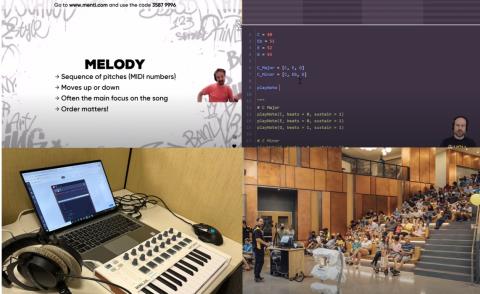Body
Image

Coding and Creating with Beats
This Developing and Testing Innovations project leverages innovative technology, using professional-quality music software to teach computer science (CS) in a way that is culturally relevant to students under-represented in computing. This project seeks to leverage innovative music technology to facilitate learning of CS. It seeks to accomplish this through 4 inter-related goals and associated objectives: (1) use design-based research to design an instructional approach that highlights how technology tools such as TunePad, scaffolding techniques, and learning activities work to support student learning and interest towards CS across contexts; (2) utilize culturally-relevant pedagogical strategies to increase participating youth knowledge, confidence, interest, and sense of belonging in CS; (3) increase participating youth awareness of CS careers and impacts of computing; and (4) increase youth participation in future CS-related opportunities at school and in informal learning environments. This project designs and conducts both online and in person coding camps for youth to participate, and collects multi-dimensional data to verify achieving the objectives.
Pillar 1: Innovative Use of Technologies in Learning and Teaching
We conducted CodeBeats, which is an innovative educational program focused on computer science (CS) and music. During out-of-school time, youth learned to use coding skills to remix and create realistic-sounding beats. We utilized the NSF-supported software TunePad and created a series of low-floor, high-ceiling scaffolding activities, including both coding and music instruction classes and independent exercises. A culminating event, the Battle of the Beats Competition, was held after the camp.
Pillar 2: Partnerships for Career and Workforce Preparation.
During our coding camps, we invited speakers who work in CS (e.g., CS college students, product managers and developers ) to talk about their studies and careers. These speakers were not only able to discuss their own careers, but were also able to interact with students, improving their beats both in terms of code and music. During our focus group interviews, we collected students’ perspectives on continuing in CS careers and their perceptions about their interactions within the community.
Pillar 3: Strategies for Equity in STEM Education
We utilized hip-hop beats to capture the interest of participating youth from diverse places of origin. We collected both quantitative (i.e., survey) and qualitative data (i.e., focus groups) to examine participating youth CS knowledge, confidence, interest, and sense of belonging in CS. The speakers we invited were also culturally diverse . This work advances hip hop pedagogy by providing many transcribed hip-hop songs (50+) which can be used as a starting point for engaging students in coding.

Discipline(s)
Computer and informational technology science
Target Gradespan(s)
Middle school (6-8)
Target Participant(s)
Youth / students
Girls (or women)
Black/African American participants
Project Setting(s)
Informal Education
Category
Developing and Testing Innovations (DTI)
Exploratory
Research Study
Youth-Based